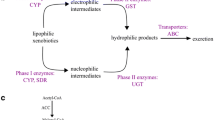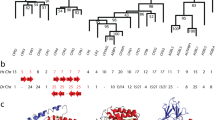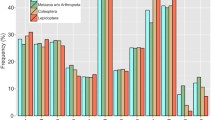Abstract
The α-esterase cluster ofD. melanogaster contains 11 esterase genes dispersed over 60 kb. Embedded in the cluster are two unrelated open reading frames that have sequence similarity with genes encoding ubiquitin-conjugating enzyme and tropomyosin. The esterase amino acid sequences show 37–66% identity with one another and all but one have all the motifs characteristic of functional members of the carboxyl/cholinesterase multigene family. The exception has several frameshift mutations and appears to be a pseudogene. Patterns of amino acid differences among cluster members in relation to generic models of carboxyl/cholinesterase protein structure are broadly similar to those among other carboxyl/cholinesterases sequenced to date. However the α-esterases differ from most other members of the family in: their lack of a signal peptide; the lack of conservation in cysteines involved in disulfide bridges; and in four indels, two of which occur in or adjacent to regions that align with proposed substrate-binding sites of other carboxyl/cholinesterases. Phylogenetic analyses clearly identify three simple gene duplication events within the cluster. The most recent event involved the pseudogene which is located in an intron of another esterase gene. However, relative rate tests suggest that the pseudogene remained functional after the duplication event and has become inactive relatively recently. The distribution of indels also suggests a deeper node in the gene phylogeny that separates six genes at the two ends of the cluster from a block of five in the middle.
Similar content being viewed by others
References
Altschul SF, Gish W, Miller W, Myers EW, Lipman DJ (1990) Basic local alignment search tool. J Mol Biol 215:403–410
Beverley SM, Wilson AC (1984) Molecular evolution inDrosophila and the Higher Diptera. II A time scale for fly evolution. J Mol Evol 21:1–13
Cavener DR, Ray SC (1991) Eukaryotic start and stop translation sites. Nucleic Acids Res 19:3185–3192
Collet C, Nielsen M, Russell RJ, Karl M, Oakeshott JG, Richmond RC (1990) Molecular analysis of duplicated esterase genes inDrosophila melanogaster. Mol Biol Evol 7:9–28
Cygler M, Schrag JD, Sussman JL, Harel M, Silman I, Gentry MK, Doctor BP (1993) Relationship between sequence conservation and three dimensional structure in a large family of esterases, lipases, and related proteins. Protein Sci 2:366–382
Felsenstein J (1991) Phylip. University of Washington, Seattle
Field LM, Williamson MS, Moores GD, Devonshire AL (1993) Cloning and analysis of the esterase genes conferring insecticide resistance in the peach-potato aphidMyzus persicae (Sulzer). Biochem J 294:569–574
Genetics Computer Group (1994) GCG version 8.0.575 Science Drive, Madison, WI 53711, USA
Gillespie JH, Kojima K (1968) The degree of polymorphism in enzymes involved in energy production compared to that in nonspecific enzymes in twoDrosophila ananassae populations. Genetics 61:582–585
Graham GJ (1995) Tandem genes and clustered genes. J Theor Biol 175:71–87
Harel M, Sussman JL, Krejci E, Bon S, Chanal P, Massoulie J, Silman I (1992) Conversion of acetylcholinesterase to butyrylcholinesterase: modeling and mutagenesis. Proc Natl Acad Sci USA 89: 10827–10831
Healy MJ, Dumancic MM, Oakeshott JG (1991) Biochemical and physiological studies of soluble esterases fromDrosophila melanogaster. Biochem Genet 29:365–388
Hughes PB, Raftos DA (1985) Genetics of an esterase associated with resistance to organophosphorus insecticides in the sheep blowfly,Lucilia cuprina (Wiedemann) (Diptera:Calliphoridae). Bull Entomol Res 75:535–544
Jentsch S, Seufert W, Sommer T, Reins H-A (1990) Ubiquitin-conjugating enzymes: novel regulators of eukaryotic cells. Trends Biochem Sci 15:195–198
Jones G, Venkataraman V, Ridley B, O'Mahony P, Turner H (1994) Structure, expression and gene sequence of a juvenile hormone esterase-related protein from metamorphosing larvae ofTrichoplusia ni. Biochem J 302:827–835
Kumar S, Tamura K, Nei M (1993) MEGA: Molecular Evolutionary Genetics Analysis version 1.0. The Pennsylvania State University, University Park, PA 16802
Lotti M, Grandori R, Fusetti F, Longhi S, Brocca S, Tramontano A, Alberghina L (1993) Cloning and analysis ofCandida cylindracea lipase sequences. Gene 124:45–55
Morton RA, Singh RS (1985) Biochemical properties, homology, and genetic variation ofDrosophila “non-specific” esterases. Biochem Genet 23:959–972
Mouchès C, Pauplin Y, Agarwal M, Lemieux L, Herzog M, Abadon M, Beyssat-Arnaouty V, Hyrien O, de Saint Vincent BR, Georghiou GP, Pasteur N (1990) Characterization of amplification core and esterase B1 gene responsible for insecticide resistance inCulex. Proc Natl Acad Sci USA 87:2574–2578
Mount SM, Burks C, Hertz G, Stormo GD, White O, Fields C (1992) Splicing signals inDrosophila: intron size, information content, and consensus sequences. Nucleic Acids Res 20:4255–4262
Mutero A, Pralavorio M, Bride J-M, Fournier D (1994) Resistance associated point mutations in insecticide-insensitive acetylcholinesterase. Proc Natl Acad Sci USA 91:5922–5926
Oakeshott JG, van Papenrecht EA, Boyce TM, Healy MJ, Russell RJ (1993) Evolutionary genetics ofDrosophila esterases. Genetica 90: 239–268
Ollis DL, Cheah E, Cygler M, Dijkstra B, Frolow F, Franken SM, Harel M, Remington SJ, Silman I, Schrag J, Sussman JL, Verschueren KHG, Goldman A (1992) The α/β hydrolase fold. Protein Eng 5:197–211
Powell JR, DeSalle R (1995)Drosophila molecular phylogenies and their uses. In: Hecht MK (ed) Evolutionary biology. Plenum Press, p 88–137
Prestridge DS (1991) Signal scan; a computer program that scans DNA sequences for eukaryotic transcriptional elements. Comput Appl Biosci 7:203–206
Riley M (1989) Nucleotide sequence of theXdh region in Drosophila pseudoobscura and an analysis of the evolution of synonymous codons. Mol Biol Evol 6:33–52
Ripoll DR, Faerman CH, Axelsen PH, Silman I, Sussman JL (1993) An electrostatic mechanism for substrate guidance down the aromatic gorge of acetylcholinesterase. Proc Natl Acad Sci USA 90:5128–5132
Rost B, Sander C (1993) Prediction of protein structure at better than 70% accuracy. J Mol Biol 232:584–599
Russell RJ, Robin GC, Kostakos P, Newcomb RD, Boyce TM, Medveczky KM, Oakeshott JG (1996) Molecular cloning of an a esterase gene cluster on chromosome 3R ofDrosophila melanogaster. Insect Biochem Mol Biol 26:235–247
Sayle R (1994) RasMac molecular graphics. Modular CHEM Consortium
Schumacher M, Camp S, Maulet Y, Newton M, MacPhee-Quigley K, Taylor SS, Friedman T, Taylor P (1986) Primary structure ofTorpedo californica acetylcholinesterase deduced from its cDNA sequence. Nature 319:407–409
Shrag JD, Cygler M (1993) 1.8A refined structure of the lipase fromGeotrichum candidum. J Mol Biol 230:575–591
Smyth KA, Russell RJ, Oakeshott JG (1994) A cluster of at least three esterase genes inLucilia cuprina includes malathion carboxylesterase and two other esterase genes implicated in resistance to organophosphates. Biochem Genet 32:437–453
Spackman ME, Oakeshott JG, Smyth K-A, Medveczky KM, Russell RJ (1994) A cluster of esterase genes on chromosome 3R ofDrosophila melanogaster includes homologues of esterase genes conferring insecticide resistance inLucilia cuprina. Biochem Genet 32:39–62
Sullivan DT, Starmer WT, Curtiss SW, Menotti-Raymond M, Yum J (1994) Unusual molecular evolution of anAdh pseudogene inDrosophila. Mol Biol Evol 11:443–458
Sussman JL, Harel M, Frolow F, Oefner C, Goldman A, Toker L, Silman I (1991) Atomic structure of acetylcholinesterase fromTorpedo califomica: a prototypic acetylcholine-binding protein. Science 253:872–879
Swofford DL (1993) PAP: Phylogenetic analysis using parsimony. Illinois Natural History Survey, Champaign, IL
Swofford DL, Begle DP (1993) Paup manual. Lab. of Molecular systematics, Smithsonian Institute
Tajima F (1993) Simple methods for testing the molecular evolutionary clock hypothesis. Genetics 135:599–607
Vaughan A, Hemingway J (1995) Mosquito carboxylesterase Estα2 (A2). J Biol Chem 270:17044–17049
Vellom DC, Radic Z, Li Y, Pickering NA, Camp S, Taylor P (1993) Amino acid residues controlling acetylcholinesterase and butyryl-cholinesterase specificity. Biochemistry 32:12–17
Villani F, White GB, Curtis CF, Miles SJ (1983) Inheritance and activity of some esterases associated with organophosphate resistance in mosquitoes of the complex ofCulex pipiens L. (Diptera: Culicidae). Bull Entomol Res 23:154–170
von Heijne G (1986) A new method for predicting signal sequence cleavage sites. Nucleic Acids Res 14:4683–4691
Weller GL, Foster GG (1993) Genetic maps of the sheep blowflyLucilia cuprina: linkage group correlations with other dipteran genera. Genome 36:495–506
Wirth MC, Marquine M, Georghiou GP, Pasteur N (1990) Esterases A2 and B2 inCulex quinquefasciatus (Diptera: Culicidae). Role in organophosphate resistance and linkage studies. J Med Entomol 7:202–206
Wright TRF, Maelmyre R (1963) A homologous gene/enzyme system. Esterase 6 inDrosophila melanogaster andDrosophila simulans. Genetics 48:1717–1726
Author information
Authors and Affiliations
Additional information
Correspondence to: C. Robin
Rights and permissions
About this article
Cite this article
Robin, C., Russell, R.J., Medveczky, K.M. et al. Duplication and divergence of the genes of the α-esterase cluster ofDrosophila melanogaster . J Mol Evol 43, 241–252 (1996). https://doi.org/10.1007/BF02338832
Received:
Accepted:
Issue Date:
DOI: https://doi.org/10.1007/BF02338832




